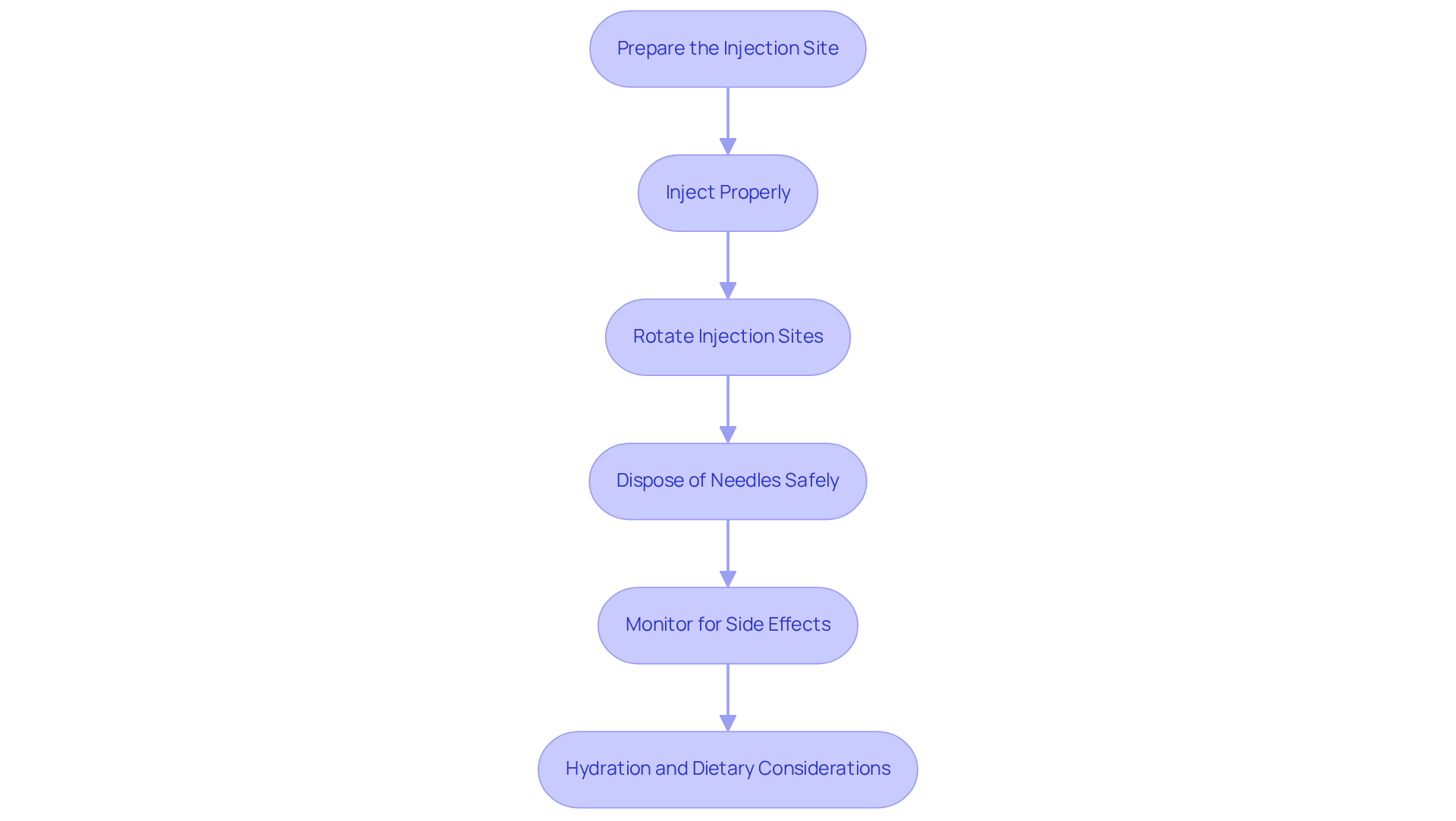Overview
This article serves as a caring guide to the semaglutide dosage chart for weight loss, outlining its administration, potential side effects, and overall effectiveness. It recognizes the challenges many face on their weight loss journey and emphasizes that semaglutide can lead to significant weight loss. Clinical studies have shown an average decrease of 14.9% in body mass, which is a promising outcome for those seeking change. However, it is crucial to highlight the importance of professional guidance in adjusting dosages and monitoring side effects, ensuring that your treatment is both safe and effective. Together, we can navigate this journey toward a healthier you.
Introduction
Navigating the complexities of weight loss can feel overwhelming, especially with the multitude of treatments available. Semaglutide, a groundbreaking GLP-1 receptor agonist, has emerged as a supportive option for those seeking effective weight management. In this guide, we explore the details of semaglutide, providing a comprehensive dosage chart and practical administration techniques, while also addressing potential side effects and contraindications.
Have you ever wondered how to effectively manage your weight loss journey alongside medication? Together, we can uncover the answers and empower your path to success with this essential resource.
Overview of Semaglutide and Its Mechanism for Weight Loss
Are you feeling overwhelmed by your weight loss journey? Semaglutide might be a helpful ally for you. This GLP-1 receptor agonist mimics the action of the glucagon-like peptide-1 hormone, a substance naturally produced in the gut that plays a vital role in regulating appetite and insulin secretion. By slowing gastric emptying, semaglutide can lead to prolonged feelings of fullness and reduced hunger, which many find encouraging.
But that’s not all—this medication also enhances insulin sensitivity and lowers glucagon secretion, both of which are essential for effective blood sugar management. Clinical studies reveal that participants often achieve significant weight loss, with many experiencing over a 10% reduction when combined with lifestyle changes. For instance, data from the SELECT trial showed that an impressive 86.4% of participants using semaglutide lost at least 5% of their body weight, with many achieving even greater reductions. This underscores how semaglutide can be a powerful tool in the fight against obesity.
However, it’s important to be aware of potential side effects, such as stomach discomfort, nausea, and reduced vitamin B12 levels with long-term use. At Minimal, we believe in a comprehensive approach to personalized weight loss solutions. We’re here for you, integrating medication with tailored fitness and nutrition guidance to support sustainable health improvements. Together, we can achieve your goals and foster a healthier lifestyle.
Interpreting the Semaglutide Dosage Chart for Effective Weight Management
Starting your journey with semaglutide can feel overwhelming, but understanding the dosage can help ease your concerns. The semaglutide dosage chart for weight loss begins with an initial dose of 0.25 mg, administered once weekly for the first four weeks. This gradual introduction allows your body to acclimate to the medication, promoting a smoother transition. After this initial stage, the semaglutide dosage chart for weight loss suggests that the dosage may be increased to 0.5 mg weekly, and then adjusted to 1.0 mg, 1.7 mg, and finally up to a maximum of 2.4 mg weekly. These adjustments are tailored to your personal tolerance and weight loss goals.
It’s essential to adhere to the prescribed schedule and make dosage adjustments only under professional guidance. Remember, consistent observation of your progress and any possible side effects is crucial to ensure the effectiveness of your treatment. Clinical trials have shown that many patients achieve significant weight loss, with an average decrease of 14.9% of their body mass over 68 weeks. This is a testament to the potential success of this medication.
Patient testimonials are powerful reminders of the positive changes that can occur. Many individuals report improved energy levels and better appetite control after finding their optimal dosage. As one healthcare provider wisely noted, “Patients should be aware of possible reactions and maintain regular consultations with their doctors to modify dosages as necessary.”
This organized approach not only enhances the benefits of semaglutide but also supports sustainable management of your body mass. Remember, you’re not alone on this journey; together, we can achieve your goals and celebrate your successes along the way.
Administering Semaglutide: Techniques and Best Practices for Optimal Results
Semaglutide is administered via subcutaneous injection, typically in the abdomen, thigh, or upper arm. To ensure you achieve the best results and support sustainable health habits, we encourage you to follow these best practices:
- Prepare the Injection Site: Begin by cleaning the area with an alcohol swab, allowing it to dry completely. This simple step minimizes the risk of infection and helps you feel more secure.
- Inject Properly: Hold the syringe at a 90-degree angle to your skin, insert the needle swiftly, and inject the medication. This technique not only aids in proper absorption but also reduces discomfort, making the process smoother for you.
- Rotate Injection Sites: To prevent irritation and complications, such as lipohypertrophy, remember to rotate your injection site each week. Aim to inject at least 2 inches away from your belly button to keep your skin healthy.
- Dispose of Needles Safely: Always use a sharps container for needle disposal. This practice is crucial for preventing injury and ensuring safe handling, allowing you to focus on your health journey.
- Monitor for Side Effects: Keep an eye on any adverse reactions, such as injection site reactions, which occur in about 0.2% of patients. These are uncommon, and using proper techniques can help prevent them. Be aware of common gastrointestinal side effects, including mild nausea and vomiting, which are typically temporary during dose escalation. According to the semaglutide dosage chart for weight loss, semaglutide can contribute to significant weight loss, enhance blood sugar management in those who are obese, and reduce the risk of heart disease and other weight-related conditions.
- Hydration and Dietary Considerations: Staying hydrated and maintaining a balanced diet are essential during your treatment. These lifestyle changes can enhance the effectiveness of your medication and contribute to your overall well-being.
By following these guidelines, you can optimize the benefits of your treatment while minimizing potential complications. Together, we can achieve your health goals, in harmony with Minimal’s comprehensive strategy for weight management and enduring health practices.
Understanding Side Effects and Contraindications of Semaglutide
While this medication is generally well-accepted, we understand that some individuals may experience reactions such as:
- nausea
- vomiting
- diarrhea
- abdominal discomfort
It’s important to know that these symptoms often lessen over time, providing some relief. However, we must also acknowledge that serious side effects can occur, including:
- pancreatitis
- acute kidney injury
- an increased risk of thyroid tumors
Notably, data indicates that pancreatitis has been documented in 389 cases linked to this medication, with 333 of those classified as severe.
If you have a personal or family history of medullary thyroid carcinoma or multiple endocrine neoplasia syndrome type 2, it’s crucial to discuss this with your healthcare provider, as semaglutide is contraindicated in these situations. Together, we can ensure that your treatment is safe and appropriate for your unique circumstances. Regular monitoring for signs of thyroid tumors and kidney function is recommended, especially for those experiencing gastrointestinal side effects, as dehydration can be a concern.
Remember, open communication with your healthcare team is key. They are here to support you and can help manage any potential side effects effectively. We’re in this together, and your well-being is our priority.
Conclusion
Semaglutide represents a significant advancement in weight management, offering a scientifically-backed approach to assist you on your weight loss journey. By mimicking the natural hormone GLP-1, semaglutide effectively regulates appetite and enhances insulin sensitivity, making it a valuable tool in combating obesity. Understanding its dosage and administration is crucial for maximizing benefits while minimizing potential side effects.
This article delves into the specifics of semaglutide, highlighting the importance of starting with a low dose and gradually increasing it under professional guidance. Key insights include:
- The effectiveness of semaglutide, as evidenced by clinical trials, which show substantial weight loss results when combined with lifestyle modifications.
- Best practices for administration.
- The necessity of monitoring side effects, ensuring a safe and effective treatment experience.
Ultimately, embracing semaglutide as part of a comprehensive weight management strategy can lead to lasting health improvements. It’s essential for you to work closely with healthcare professionals to tailor your treatment plan and address any concerns. By prioritizing open communication and adhering to recommended guidelines, you can leverage the full potential of semaglutide and embark on a successful path toward achieving your weight loss goals. Remember, together, we can achieve your goals.
Frequently Asked Questions
What is semaglutide and how does it work for weight loss?
Semaglutide is a GLP-1 receptor agonist that mimics the action of the glucagon-like peptide-1 hormone, which regulates appetite and insulin secretion. It aids weight loss by slowing gastric emptying, leading to prolonged feelings of fullness and reduced hunger.
What additional benefits does semaglutide provide besides weight loss?
In addition to promoting weight loss, semaglutide enhances insulin sensitivity and lowers glucagon secretion, both of which are important for effective blood sugar management.
How effective is semaglutide for weight loss in clinical studies?
Clinical studies indicate significant weight loss among participants using semaglutide, with many achieving over a 10% reduction in body weight when combined with lifestyle changes. For example, in the SELECT trial, 86.4% of participants lost at least 5% of their body weight.
What are some potential side effects of semaglutide?
Potential side effects of semaglutide include stomach discomfort, nausea, and reduced vitamin B12 levels with long-term use.
How does Minimal approach weight loss solutions with semaglutide?
Minimal believes in a comprehensive approach to personalized weight loss solutions, integrating semaglutide medication with tailored fitness and nutrition guidance to support sustainable health improvements.


















